Marketing Report: Consumer Behavior Analysis on Google Home Hub Usage
VerifiedAdded on 2022/10/17
|7
|1306
|33
Report
AI Summary
This report delves into the realm of consumer behavior, focusing on various learning approaches with a particular emphasis on cognitive learning theory. The analysis centers on the application of these theories to the usage of Google Home Hub, a recently introduced product. The report examines different approaches to consumer learning, including behavior and cognitive theories, highlighting how these approaches influence consumer knowledge, product perception, and purchasing decisions. It explores how the cognitive learning theory is applicable to Google Home Hub users, including early innovators and family members, and investigates how they gather and process information about the product. The study also contrasts the target customer groups, differentiating between early adopters and family members, and correlates cognitive learning theory with the target audience of family members. The report concludes with a reference list of scholarly articles supporting the analysis.

Running head: MARKETING
Consumer behaviour
Name of the student:
Name of the university:
Author note:
Consumer behaviour
Name of the student:
Name of the university:
Author note:
Paraphrase This Document
Need a fresh take? Get an instant paraphrase of this document with our AI Paraphraser

1
MARKETING
Table of contents
Different approaches to consumer learning...............................................................................2
Applicability of cognitive learning theory on the usage of Google Home Hub........................3
Difference in the target customer groups...................................................................................5
References..................................................................................................................................6
MARKETING
Table of contents
Different approaches to consumer learning...............................................................................2
Applicability of cognitive learning theory on the usage of Google Home Hub........................3
Difference in the target customer groups...................................................................................5
References..................................................................................................................................6
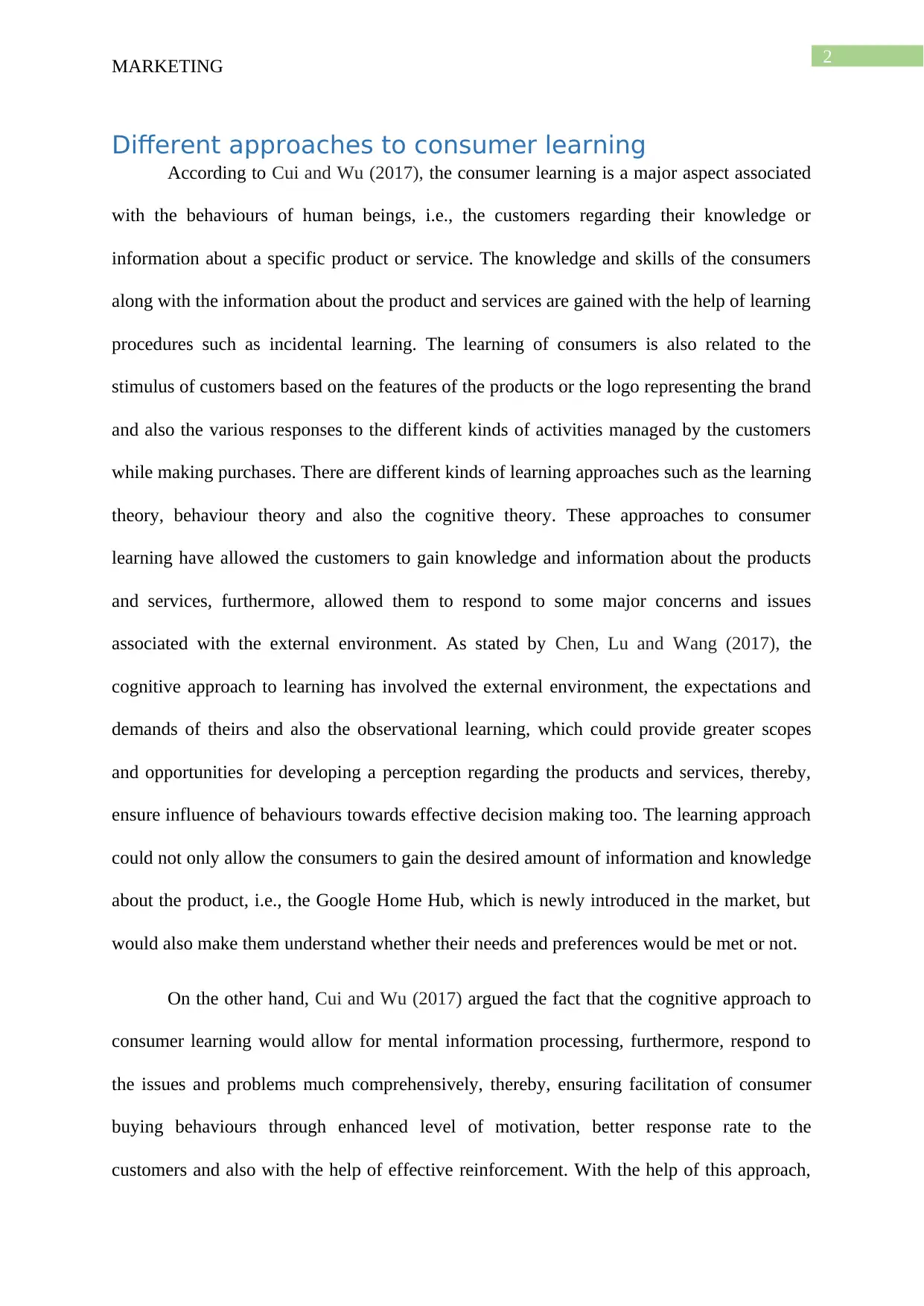
2
MARKETING
Different approaches to consumer learning
According to Cui and Wu (2017), the consumer learning is a major aspect associated
with the behaviours of human beings, i.e., the customers regarding their knowledge or
information about a specific product or service. The knowledge and skills of the consumers
along with the information about the product and services are gained with the help of learning
procedures such as incidental learning. The learning of consumers is also related to the
stimulus of customers based on the features of the products or the logo representing the brand
and also the various responses to the different kinds of activities managed by the customers
while making purchases. There are different kinds of learning approaches such as the learning
theory, behaviour theory and also the cognitive theory. These approaches to consumer
learning have allowed the customers to gain knowledge and information about the products
and services, furthermore, allowed them to respond to some major concerns and issues
associated with the external environment. As stated by Chen, Lu and Wang (2017), the
cognitive approach to learning has involved the external environment, the expectations and
demands of theirs and also the observational learning, which could provide greater scopes
and opportunities for developing a perception regarding the products and services, thereby,
ensure influence of behaviours towards effective decision making too. The learning approach
could not only allow the consumers to gain the desired amount of information and knowledge
about the product, i.e., the Google Home Hub, which is newly introduced in the market, but
would also make them understand whether their needs and preferences would be met or not.
On the other hand, Cui and Wu (2017) argued the fact that the cognitive approach to
consumer learning would allow for mental information processing, furthermore, respond to
the issues and problems much comprehensively, thereby, ensuring facilitation of consumer
buying behaviours through enhanced level of motivation, better response rate to the
customers and also with the help of effective reinforcement. With the help of this approach,
MARKETING
Different approaches to consumer learning
According to Cui and Wu (2017), the consumer learning is a major aspect associated
with the behaviours of human beings, i.e., the customers regarding their knowledge or
information about a specific product or service. The knowledge and skills of the consumers
along with the information about the product and services are gained with the help of learning
procedures such as incidental learning. The learning of consumers is also related to the
stimulus of customers based on the features of the products or the logo representing the brand
and also the various responses to the different kinds of activities managed by the customers
while making purchases. There are different kinds of learning approaches such as the learning
theory, behaviour theory and also the cognitive theory. These approaches to consumer
learning have allowed the customers to gain knowledge and information about the products
and services, furthermore, allowed them to respond to some major concerns and issues
associated with the external environment. As stated by Chen, Lu and Wang (2017), the
cognitive approach to learning has involved the external environment, the expectations and
demands of theirs and also the observational learning, which could provide greater scopes
and opportunities for developing a perception regarding the products and services, thereby,
ensure influence of behaviours towards effective decision making too. The learning approach
could not only allow the consumers to gain the desired amount of information and knowledge
about the product, i.e., the Google Home Hub, which is newly introduced in the market, but
would also make them understand whether their needs and preferences would be met or not.
On the other hand, Cui and Wu (2017) argued the fact that the cognitive approach to
consumer learning would allow for mental information processing, furthermore, respond to
the issues and problems much comprehensively, thereby, ensuring facilitation of consumer
buying behaviours through enhanced level of motivation, better response rate to the
customers and also with the help of effective reinforcement. With the help of this approach,
⊘ This is a preview!⊘
Do you want full access?
Subscribe today to unlock all pages.

Trusted by 1+ million students worldwide
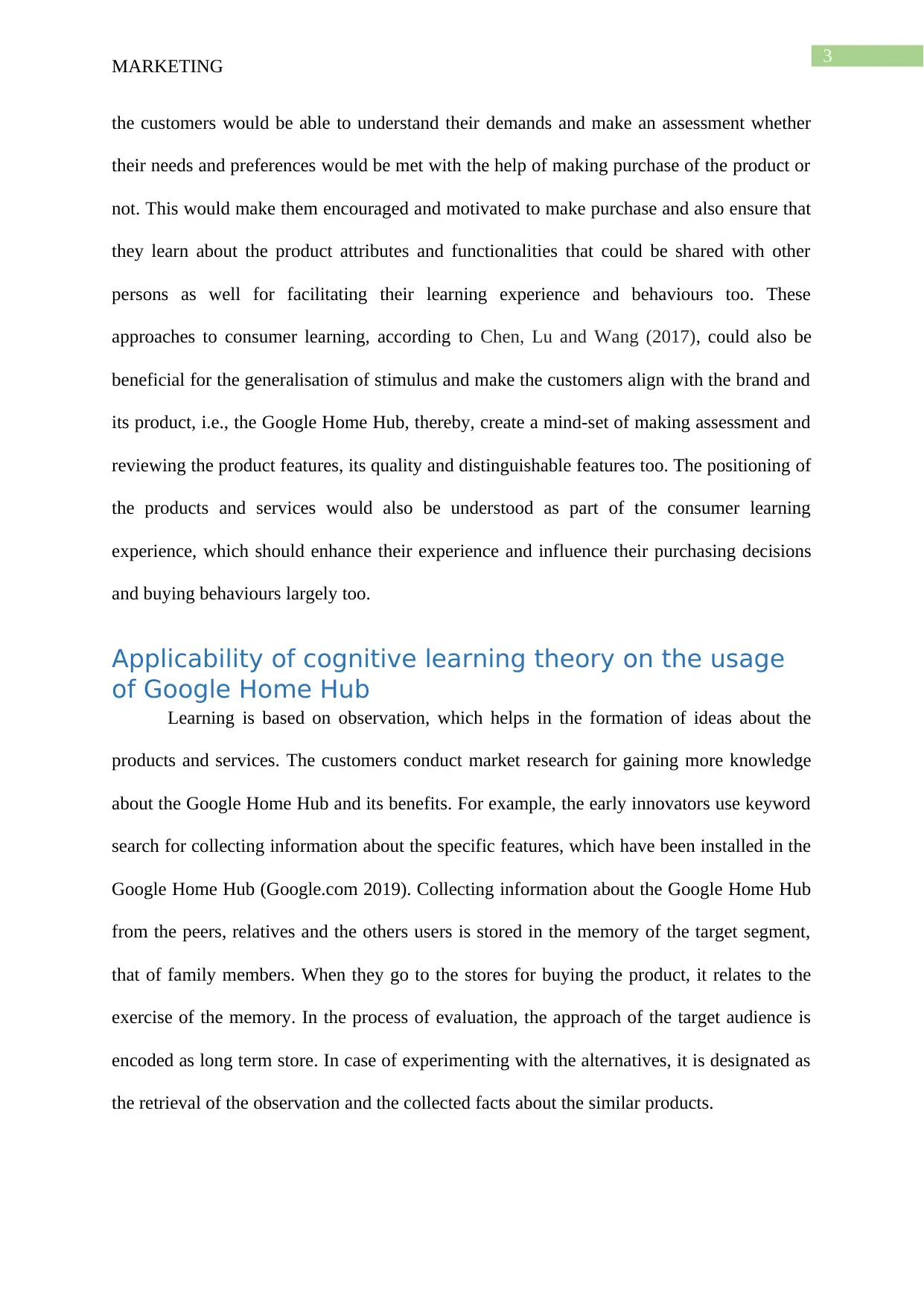
3
MARKETING
the customers would be able to understand their demands and make an assessment whether
their needs and preferences would be met with the help of making purchase of the product or
not. This would make them encouraged and motivated to make purchase and also ensure that
they learn about the product attributes and functionalities that could be shared with other
persons as well for facilitating their learning experience and behaviours too. These
approaches to consumer learning, according to Chen, Lu and Wang (2017), could also be
beneficial for the generalisation of stimulus and make the customers align with the brand and
its product, i.e., the Google Home Hub, thereby, create a mind-set of making assessment and
reviewing the product features, its quality and distinguishable features too. The positioning of
the products and services would also be understood as part of the consumer learning
experience, which should enhance their experience and influence their purchasing decisions
and buying behaviours largely too.
Applicability of cognitive learning theory on the usage
of Google Home Hub
Learning is based on observation, which helps in the formation of ideas about the
products and services. The customers conduct market research for gaining more knowledge
about the Google Home Hub and its benefits. For example, the early innovators use keyword
search for collecting information about the specific features, which have been installed in the
Google Home Hub (Google.com 2019). Collecting information about the Google Home Hub
from the peers, relatives and the others users is stored in the memory of the target segment,
that of family members. When they go to the stores for buying the product, it relates to the
exercise of the memory. In the process of evaluation, the approach of the target audience is
encoded as long term store. In case of experimenting with the alternatives, it is designated as
the retrieval of the observation and the collected facts about the similar products.
MARKETING
the customers would be able to understand their demands and make an assessment whether
their needs and preferences would be met with the help of making purchase of the product or
not. This would make them encouraged and motivated to make purchase and also ensure that
they learn about the product attributes and functionalities that could be shared with other
persons as well for facilitating their learning experience and behaviours too. These
approaches to consumer learning, according to Chen, Lu and Wang (2017), could also be
beneficial for the generalisation of stimulus and make the customers align with the brand and
its product, i.e., the Google Home Hub, thereby, create a mind-set of making assessment and
reviewing the product features, its quality and distinguishable features too. The positioning of
the products and services would also be understood as part of the consumer learning
experience, which should enhance their experience and influence their purchasing decisions
and buying behaviours largely too.
Applicability of cognitive learning theory on the usage
of Google Home Hub
Learning is based on observation, which helps in the formation of ideas about the
products and services. The customers conduct market research for gaining more knowledge
about the Google Home Hub and its benefits. For example, the early innovators use keyword
search for collecting information about the specific features, which have been installed in the
Google Home Hub (Google.com 2019). Collecting information about the Google Home Hub
from the peers, relatives and the others users is stored in the memory of the target segment,
that of family members. When they go to the stores for buying the product, it relates to the
exercise of the memory. In the process of evaluation, the approach of the target audience is
encoded as long term store. In case of experimenting with the alternatives, it is designated as
the retrieval of the observation and the collected facts about the similar products.
Paraphrase This Document
Need a fresh take? Get an instant paraphrase of this document with our AI Paraphraser
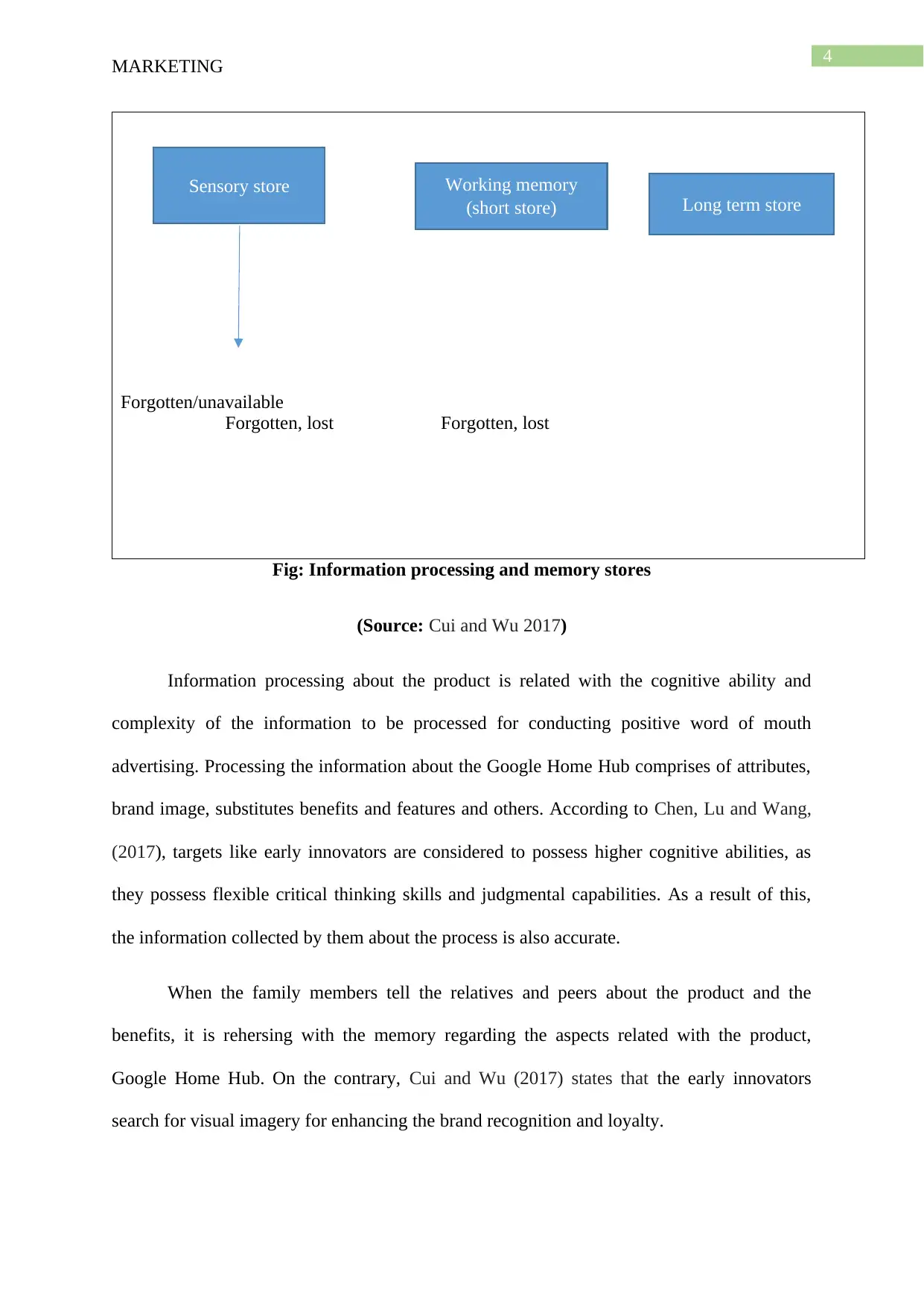
4
MARKETING
Forgotten/unavailable
Forgotten, lost Forgotten, lost
Fig: Information processing and memory stores
(Source: Cui and Wu 2017)
Information processing about the product is related with the cognitive ability and
complexity of the information to be processed for conducting positive word of mouth
advertising. Processing the information about the Google Home Hub comprises of attributes,
brand image, substitutes benefits and features and others. According to Chen, Lu and Wang,
(2017), targets like early innovators are considered to possess higher cognitive abilities, as
they possess flexible critical thinking skills and judgmental capabilities. As a result of this,
the information collected by them about the process is also accurate.
When the family members tell the relatives and peers about the product and the
benefits, it is rehersing with the memory regarding the aspects related with the product,
Google Home Hub. On the contrary, Cui and Wu (2017) states that the early innovators
search for visual imagery for enhancing the brand recognition and loyalty.
Sensory store Working memory
(short store) Long term store
MARKETING
Forgotten/unavailable
Forgotten, lost Forgotten, lost
Fig: Information processing and memory stores
(Source: Cui and Wu 2017)
Information processing about the product is related with the cognitive ability and
complexity of the information to be processed for conducting positive word of mouth
advertising. Processing the information about the Google Home Hub comprises of attributes,
brand image, substitutes benefits and features and others. According to Chen, Lu and Wang,
(2017), targets like early innovators are considered to possess higher cognitive abilities, as
they possess flexible critical thinking skills and judgmental capabilities. As a result of this,
the information collected by them about the process is also accurate.
When the family members tell the relatives and peers about the product and the
benefits, it is rehersing with the memory regarding the aspects related with the product,
Google Home Hub. On the contrary, Cui and Wu (2017) states that the early innovators
search for visual imagery for enhancing the brand recognition and loyalty.
Sensory store Working memory
(short store) Long term store
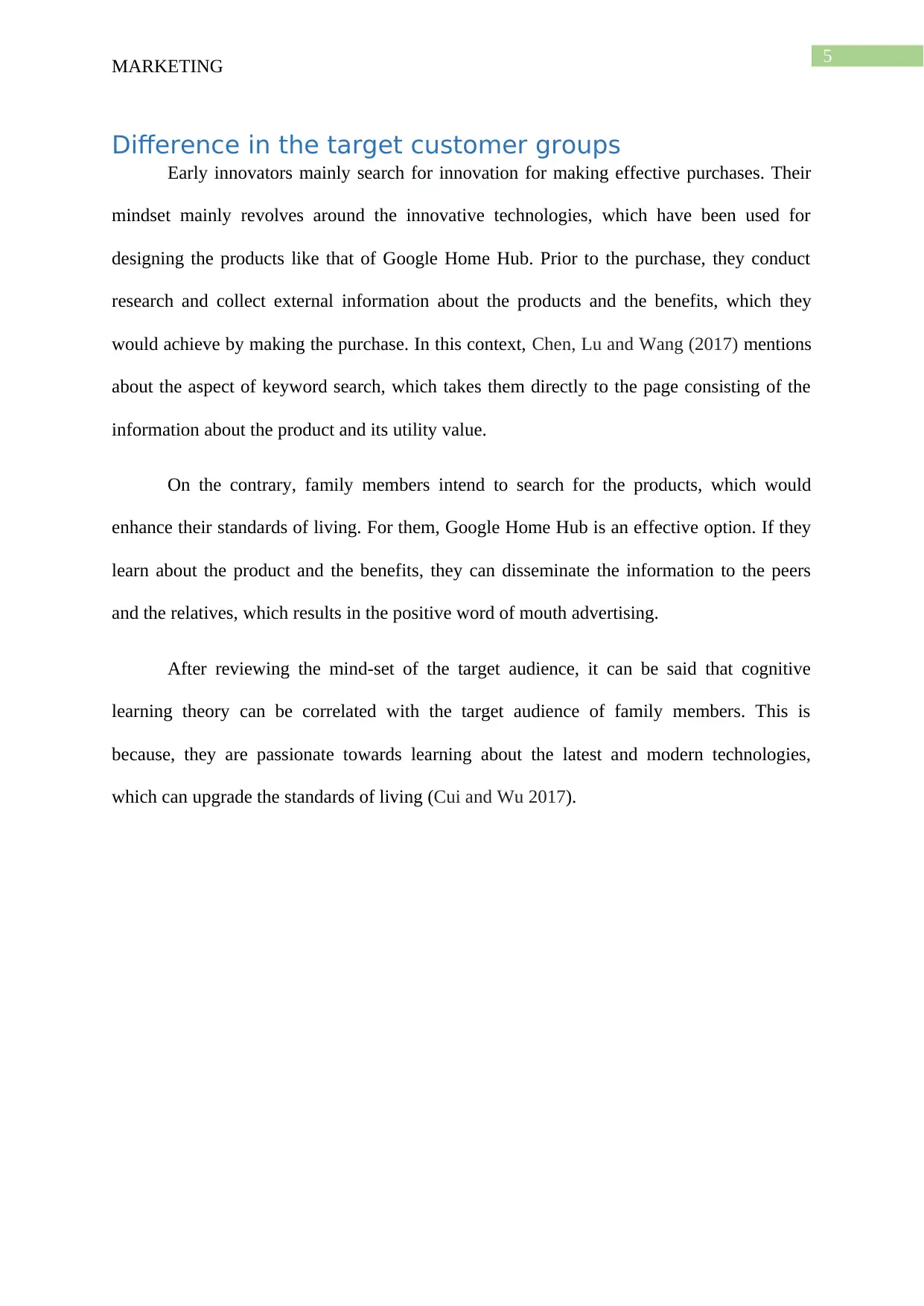
5
MARKETING
Difference in the target customer groups
Early innovators mainly search for innovation for making effective purchases. Their
mindset mainly revolves around the innovative technologies, which have been used for
designing the products like that of Google Home Hub. Prior to the purchase, they conduct
research and collect external information about the products and the benefits, which they
would achieve by making the purchase. In this context, Chen, Lu and Wang (2017) mentions
about the aspect of keyword search, which takes them directly to the page consisting of the
information about the product and its utility value.
On the contrary, family members intend to search for the products, which would
enhance their standards of living. For them, Google Home Hub is an effective option. If they
learn about the product and the benefits, they can disseminate the information to the peers
and the relatives, which results in the positive word of mouth advertising.
After reviewing the mind-set of the target audience, it can be said that cognitive
learning theory can be correlated with the target audience of family members. This is
because, they are passionate towards learning about the latest and modern technologies,
which can upgrade the standards of living (Cui and Wu 2017).
MARKETING
Difference in the target customer groups
Early innovators mainly search for innovation for making effective purchases. Their
mindset mainly revolves around the innovative technologies, which have been used for
designing the products like that of Google Home Hub. Prior to the purchase, they conduct
research and collect external information about the products and the benefits, which they
would achieve by making the purchase. In this context, Chen, Lu and Wang (2017) mentions
about the aspect of keyword search, which takes them directly to the page consisting of the
information about the product and its utility value.
On the contrary, family members intend to search for the products, which would
enhance their standards of living. For them, Google Home Hub is an effective option. If they
learn about the product and the benefits, they can disseminate the information to the peers
and the relatives, which results in the positive word of mouth advertising.
After reviewing the mind-set of the target audience, it can be said that cognitive
learning theory can be correlated with the target audience of family members. This is
because, they are passionate towards learning about the latest and modern technologies,
which can upgrade the standards of living (Cui and Wu 2017).
⊘ This is a preview!⊘
Do you want full access?
Subscribe today to unlock all pages.

Trusted by 1+ million students worldwide
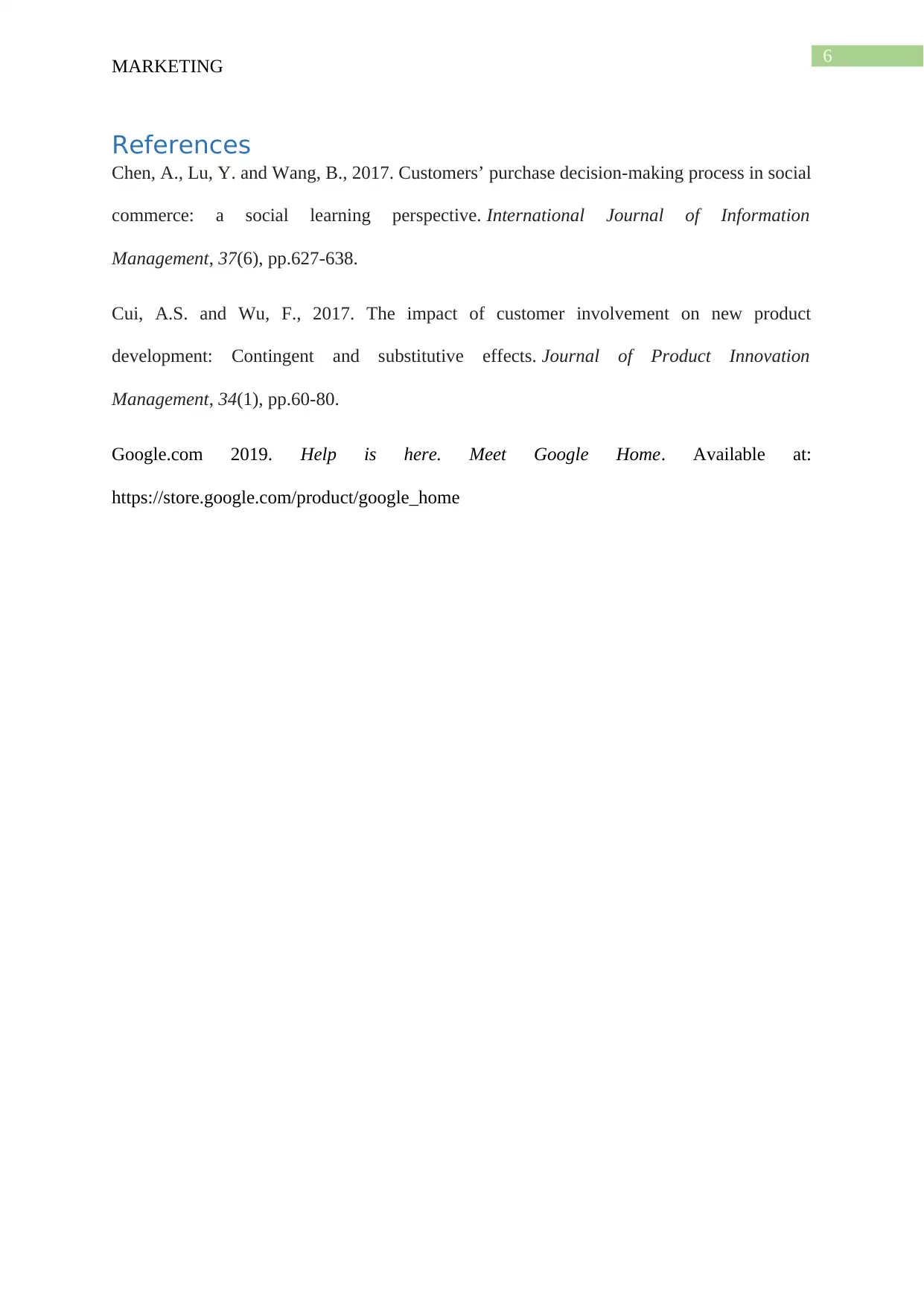
6
MARKETING
References
Chen, A., Lu, Y. and Wang, B., 2017. Customers’ purchase decision-making process in social
commerce: a social learning perspective. International Journal of Information
Management, 37(6), pp.627-638.
Cui, A.S. and Wu, F., 2017. The impact of customer involvement on new product
development: Contingent and substitutive effects. Journal of Product Innovation
Management, 34(1), pp.60-80.
Google.com 2019. Help is here. Meet Google Home. Available at:
https://store.google.com/product/google_home
MARKETING
References
Chen, A., Lu, Y. and Wang, B., 2017. Customers’ purchase decision-making process in social
commerce: a social learning perspective. International Journal of Information
Management, 37(6), pp.627-638.
Cui, A.S. and Wu, F., 2017. The impact of customer involvement on new product
development: Contingent and substitutive effects. Journal of Product Innovation
Management, 34(1), pp.60-80.
Google.com 2019. Help is here. Meet Google Home. Available at:
https://store.google.com/product/google_home
1 out of 7
Related Documents
Your All-in-One AI-Powered Toolkit for Academic Success.
+13062052269
info@desklib.com
Available 24*7 on WhatsApp / Email
![[object Object]](/_next/static/media/star-bottom.7253800d.svg)
Unlock your academic potential
Copyright © 2020–2025 A2Z Services. All Rights Reserved. Developed and managed by ZUCOL.



